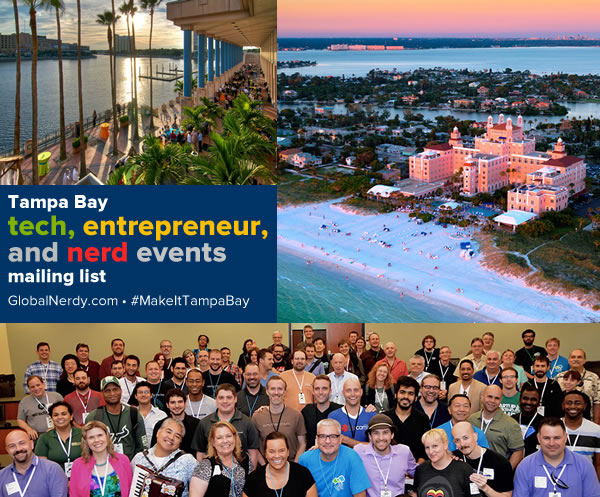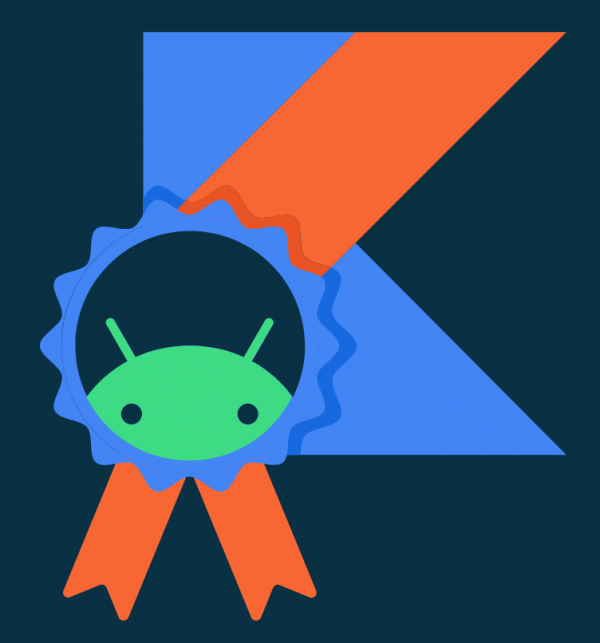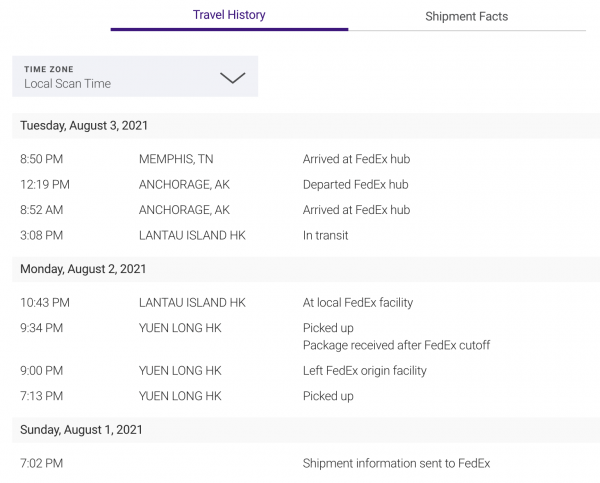
Here’s your weekly list of tech, entrepreneur, and nerd events — plus a little area tech news — for Tampa Bay and surrounding areas for the week of Monday, August 9 through Sunday, August 15, 2021.
This is a weekly service from Tampa Bay’s tech blog, Global Nerdy! For the past four years, I’ve been compiling a list of tech, entrepreneur, and nerd events happening in Tampa Bay and surrounding areas. There’s a lot going on in our scene here in “The Other Bay Area, on the Other West Coast”!
This list includes events that would be of interest to techies, nerds, and entrepreneurs. It includes (but isn’t limited to) events that fall under the category of:
- Programming, DevOps, systems administration, and testing
- Tech project management / agile processes
- Video, board, and role-playing games
- Book, philosophy, and discussion clubs
- Tech, business, and entrepreneur networking events
- Toastmasters (because nerds really need to up their presentation game)
- Sci-fi, fantasy, and other genre fandoms
- Anything I deem geeky
I’m moving this list to Fridays so that you’ve got more time to plan for the upcoming week. Let me know if this change works for you (or if it doesn’t)!
By “Tampa Bay and surrounding areas”, this list covers events that originate or are aimed at the area within 100 miles of the Port of Tampa. At the very least, that includes the cities of Tampa, St. Petersburg, and Clearwater, but as far north as Ocala, as far south as Fort Myers, and includes Orlando and its surrounding cities.
This week’s events
Monday, August 9
- SW Florida Business Network — SWFL Business Network – Monday Meetings @ 7:30 AM to 9:30 AM
- Entrepreneurs & Business Owners of Sarasota & Bradenton — Virtual Networking Lunch Monday & Wednesday @ 11:30 AM to 1:00 PM
- Tampa / St Pete Business Connections — South Tampa Professional Networking Lunch @ 11:30 AM to 1:00 PM
- Wesley Chapel, Trinity, New Tampa Business Professionals — Lutz, Wesley Chapel, New Tampa Virtual Networking Lunch @ 11:30 AM to 1:00 PM
- Young Professionals of Tampa Bay Networking Group — South Tampa Referrals @ 11:30 AM to 1:00 PM
- Christian Professionals Network Tampa Bay — Live Online Networking- Monday @ 11:30 AM to 12:30 PM
- Professional Business Networking with RGAnetwork.net — South Tampa Business Networking Lunch @ 11:30 AM to 1:30 PM
- Tampa Bay Tech Career Advice Forum — Paid Training & Work Experience Program Orientation – Hillsborough County @ 2:00 PM to 3:00 PM
- Career Success Academy — Paid Work Experience Orientation @ 2:00 PM to 3:30 PM
- Tampa Tabletop — Monday Feast & Game Night @ 6:00 PM to 11:00 PM
- Davenport Book Club — Davenport Book Club- August Discussion @ 7:00 PM to 8:00 PM
- Tampa Bay Women in Tech — Monday Night Pulse Check @ 7:00 PM to 8:30 PM
- Toastmasters District 48 — Successful Leadership? There’s an APP for that! APPly Your Speaking Skills More! @ 7:00 PM to 8:15 PM
- Liberal Enlightened Forward Thinking Singles — August Book Club @ 7:00 PM to 8:30 PM
- Library Book Clubs – OCLS — Virtual Event: Southeast Book Club @ 7:00 PM to 8:00 PM
Tuesday, August 10
- Toastmasters, Division D — CEO Toastmasters @ 8:00 AM to 9:00 AM
- Dr. Phillips Chamber of Commerce — Face-To-Face Meeting Metrowest Exclusive Leads Group Meeting @ 8:30 AM to 9:30 AM
- Tampa Bay Tech Career Advice Forum — Top Interview Questions: What They Mean & Why They’re Asking @ 10:00 AM to 11:30 AM
- Englewood Sisterhood 50+ — Book Club @ 10:30 AM to 12:30 PM
- Suncoast Business Network — Business Networking Lunch @ 11:30 AM to 1:00 PM
- PDM-SWUG, SolidWorks User Group — PDM SWUG’s Breakfast, Lunch & Dinner! (and maybe a midnight snack) @ 12:00 PM to 1:00 PM
- Tampa Bay Tech Career Advice Forum — LinkedIn Local Tampa Bay – Virtual Edition @ 5:30 PM to 7:00 PM
- Lean Startup Orlando — Innovation at the City of Orlando @ 5:30 PM to 7:30 PM
- Toastmasters Division E — Bartow (FL) Toastmasters Club, ONLINE @ 6:00 PM to 7:00 PM
- Ladies of Tampa Bay — SURVEY SAYS (Family Feud Game) @ The Thirsty Marlin @ 6:30 PM to 9:00 PM
- Toastmasters District 48 — South Shore Toastmasters @ 6:30 PM to 8:00 PM
- Sisters in Technology — Sisters Tech Network after work meeting online @ 6:30 PM to 7:00 PM
- Florida Podcasters Association — Florida Podcasters Association General Meeting!!! @ 6:30 PM to 8:00 PM
- The Sarasota Creative Writers Meetup Group — The Sarasota Creative Writers @ 6:30 PM to 9:30 PM
- Tampa Bay Women in Tech — Let’s Meet Up for Dinner and Discourse! @ 7:00 PM to 8:00 PM
- Lakeland Note Investing Group — Lakeland Note Investing Meetup Group @ 7:00 PM to 8:00 PM
- Let’s Try It: A Badass Adventure Group — Badass Adventure Planning and Badass Games @ 7:00 PM to 9:00 PM
- The Villagers South of 44 — New South of 44 Book Club- Every Second Tuesday @ 7:00 PM to 9:00 PM
- Shut Up & Write!® Tampa — Online Event: Shut Up & Write on Zoom @ 7:45 PM to 9:15 PM
Wednesday, August 11
- Networking 4 Profit — Referral Networking Meeting Orlando Area @ 7:30 AM to 9:00 AM
- 1 Million Cups Orlando @ 9:00 AM
- 1 Million Cups St Pete @ 9:00 AM
- 1 Million Cups Tampa — The Nice Guy Entrepreneur / Hogan Made @ 9:00 AM
- North Tampa Networking Group — Business networking @ 9:00 AM to 10:00 AM
- Business Networking and Other Events — Morning Speed-Networking @ 9:30 AM to 11:30 AM
- United Inventors Association – Roadmap to Success @ 10:00 AM to 12:00 PM
- Success Strategies for Business Owners — Summer Technology Tune-up – EXCEL August Series @ 12:00 PM to 1:00 PM
- TampaBayNetworkers — Pinellas Sales Force @ 12:00 PM to 1:30 PM
- Grit Daily — Grit Daily Congressional Startup Day & Pitch Competition @ 1:00 PM to 5:00 PM
- Jobs App Startup-Applicacion para Trabajos — App opportunity-Participe de nuestra aplicacion @ 2:30 PM to 3:30 PM
- Tampa Gaming Guild — Wednesday Night Gaming @ 5:30 PM to 11:00 PM
- Florida Narcissistic Abuse Recovery Group — August 2021 Book Club- 13 Things Mentally Strong People Don’t Do @ 5:30 PM to 6:30 PM
- Tampa Writers Alliance — Tampa Writers Alliance Critique Group @ 6:30 PM to 8:30 PM
- Thinkful Tampa | Careers in Tech — Thinkful Webinar | Intro to HTML & CSS: Build Your Own Website @ 8:00 PM to 10:00 PM
Thursday, August 12
- Orlando Business Referral Group (BNI-Professional Alliance) — BNI Professional Alliance-A Business Referral Group @ 8:00 AM to 9:30 AM
- Business Networking and Other Events — Breakfast Networking Meeting @ 8:30 AM to 10:30 AM
- Tampa Bay Tech Career Advice Forum — Successful Networking Tips for Introverts with Janet Parnes @ 11:30 AM to 1:00 PM
- Power Business Networking — Power Business Networking Thursday 11:45 am 2021 08 12 @ 11:45 AM to 1:15 PM
- The Reliable Speakers Toastmasters Club — The Reliable Speakers Toastmasters – Weekly Meeting @ 12:00 PM to 1:00 PM
- Business to Business Networking Group — NEW!!! B2B Networking Group Forming @ 12:00 PM to 2:00 PM
- MegaCon Orlando 2021 @ Thursday 4:00 PM to Sunday 5:00 PM
- TIE Tampa Bay — Funding Florida’s Growth @ 5:30 PM to 7:30 PM
- Tampa Bay WaVE — Sip & Learn with Walter Phuego @ 7:00 PM to 8:00 PM
- Library Book Clubs – OCLS — Virtual Event: Alafaya Book Club @ 7:00 PM to 8:00 PM
- Drunk’n Meeples the Social Tabletop (Board) Gamers — THURSDAY Game Night @ de Bine Brewing Co. @ 7:00 PM to 11:00 PM
- Tampa Cybersecurity Meetup | Flatiron School — Cybersecurity 101 @ 8:00 PM to 9:00 PM
- Thinkful Tampa | Careers in Tech — Thinkful Webinar | Free Crash Course: Natural Language Processing @ 9:30 PM to 11:30 PM
Friday, August 13
- Elevated for Success Women’s Networking Group — Connect and Chat – Roundtable Mastermind @ 9:00 AM to 11:00 AM
- Powerful Women Networking — WINTER PARK: Join us for outrageous connection, growth and networking too! @ 11:30 AM to 1:30 PM
- Tampa Bay Tech Career Advice Forum — How to Tell Your Career Story with Liz M Lopez @ 7:00 PM to 8:30 PM
- America’s TriviAddiction — THE EAGLES GOLF CLUB – ODESSA, FLORIDA – LIVE TEAM TRIVIA !!! @ 7:00 PM to 9:00 PM
Saturday, August 14
- Winter Park Feminist Book Club Meetup Group — Gloria Steinem, My Life On The Road @ 9:15 AM to 10:15 AM
- Writers 4 All Seasons Tampa Bay — Writers 4 All Seasons Tampa Bay Zoom meeting @ 1:00 PM to 3:00 PM
- Nerd Night Out — NNO Book Club: The Three-Body Problem @ 1:00 PM to 3:00 PM
- Adult Craft Club – OCLS — Virtual Class: Let’s Crochet a Poke-Ball Key Chain! @ 3:00 PM to 4:30 PM
- Board Games and Card Games in Sarasota & Bradenton — Online Meetup: Terraforming Mars @ 7:00 PM to 9:00 PM
- Tampa Bay Drone Club — Summer Nights – Open Fly @ 9:00 PM to 11:00 PM
Sunday, August 15
- Toastmasters, Division D — Weekend Toastmasters @ 3:00 PM to 4:30 PM
- Lithia Dungeons & Dragons And Gaming Guild — 5E (ish) AD&D – Humble Beginnings Campaign (Trouble in Elm). @ 6:00 PM to 9:00 PM
Tampa Bay Tech News
Fast, the one-click-checkout-as-a-service company, chooses Tampa as its east coast hub
From St. Pete Catalyst:
San Francisco-based fintech startup Fast, an online checkout company, is expanding to Tampa.
Fast announced the plans on Tuesday during an event in partnership with Tampa Mayor Jane Castor, NASCAR driver Parker Kligerman and other local athletes at Sparkman Wharf.
Fast CEO Domm Holland will lead the efforts to expand in Tampa and name it the company’s East Coast hub. Holland co-founded the company with former Uber operations executive Allison Barr Allen.
“I’ve been asked by many Silicon Valley friends why Tampa? One of the biggest reasons is Mayor Jane Castor,” Holland said, crediting her understanding of his business needs and how Fast fits into the city’s goals of bolstering the tech sector.
“I wanted to be in an area brimming with innovative energy and stocked with skilled talent,” Holland said.
Want to know more about Fast? Check out this article in protocol, Fast has a plan to reinvent online shopping. And then kill the password as well as this interview from episode 1103 of This Week In Startups where Jason Calacanis interviews Domm Holland:
Tampa-based tech company, Blue.cloud, nimbly transitions to successfully grow revenue 200% amidst pandemic
From That’s So Tampa:
Here in Tampa Bay, a not-so-quiet tech boom was already underway. From Oldsmar and Clearwater to Tampa and St. Pete, more and more tech companies were choosing to move to – or get their start in – the area. So when the world transitioned from hard copy to the cloud, the region was well-prepared to step into the role everyone needed: help figuring all that stuff out.
Perhaps the best example is Blue.cloud, a cloud-only digital transformation company that got its start in Tampa Bay. Having already been in operation for more than 15 years, Blue.cloud (formerly Bluenet, founded in 2004) was one of the industry leaders in a perfect position to leap to the rescue last March.
Do you have any events or announcements that you’d like to see on this list?
Let me know at joey@joeydevilla.com!
Join the mailing list!
If you’d like to get this list in your email inbox every week, enter your email address below. You’ll only be emailed once a week, and the email will contain this list, plus links to any interesting news, upcoming events, and tech articles. Join the Tampa Bay Tech Events list and always be informed of what’s coming up in Tampa Bay!











